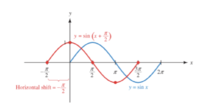Can anyone explain why horizontal shifts for functions when a term is added to the argument go the opposite direction of the sign of the additional term? For example:
[MATH]y = sin(x + pi/2)[/MATH]
is shifted [MATH]pi/2[/MATH] to the left instead of to the right (see figure below from Mckeague/Turner Trigonometry 8E).

Why doesn't the shift occur to the right instead? If we have a term added outside the argument, such as [MATH]y = sin (x) + 3[/MATH] then the vertical shift is in the same direction of the sign of the additional term. If we assume that the [MATH]x[/MATH] in the argument starts at the typical place, 0, then why doesn't the [MATH]pi/2[/MATH] get added to the argument of the function, like:

instead of starting the period at [MATH]-pi/2[/MATH] by adding [MATH]-pi/2[/MATH]? Is it because the argument needs to start as a 0?
[MATH]y = sin(x + pi/2)[/MATH]
is shifted [MATH]pi/2[/MATH] to the left instead of to the right (see figure below from Mckeague/Turner Trigonometry 8E).

Why doesn't the shift occur to the right instead? If we have a term added outside the argument, such as [MATH]y = sin (x) + 3[/MATH] then the vertical shift is in the same direction of the sign of the additional term. If we assume that the [MATH]x[/MATH] in the argument starts at the typical place, 0, then why doesn't the [MATH]pi/2[/MATH] get added to the argument of the function, like:

instead of starting the period at [MATH]-pi/2[/MATH] by adding [MATH]-pi/2[/MATH]? Is it because the argument needs to start as a 0?
